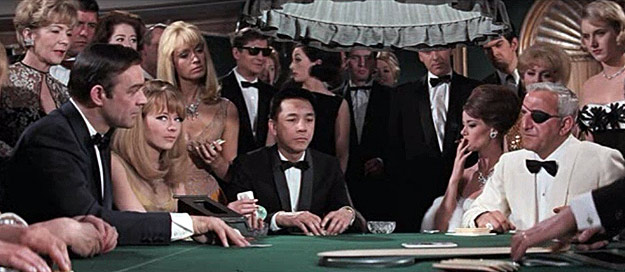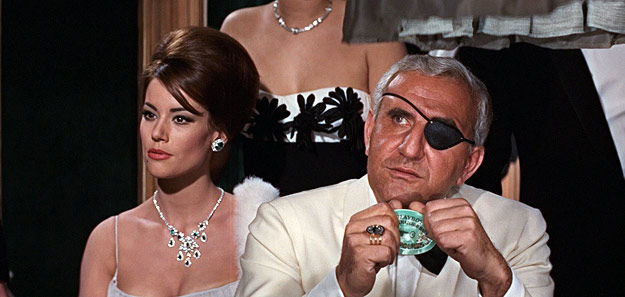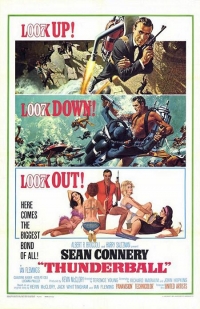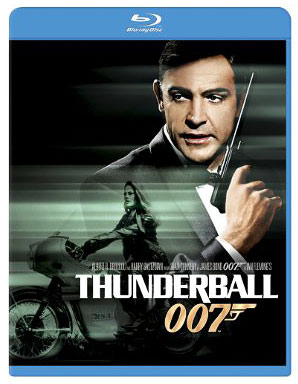Coate: Thunderball was the first 007 movie produced in ’Scope. How did this change in photography and projection style affect the movie (and series)?
Chapman: Yes, Thunderball was the first Bond movie produced in widescreen: Panavision, which had more or less become the industry standard for anamorphic ’scope cinematography in the early to mid-1960s. In a sense it’s something of a mystery why the previous films were not shot in widescreen. It can’t have been a budgetary factor as widescreen wasn’t so expensive by this time and many films with a lower budget than Dr. No used it. So it must have been an aesthetic choice not to use it in the early films, maybe down to cinematographer Ted Moore…. I don’t have any firm evidence to support this theory, but it may have been that the decision to use Panavision for Thunderball had something to do with Kevin McClory. The trade press announcement for the unmade James Bond of the Secret Service in October 1959 said that it was to be shot in Todd-AO—what might be called a “super” or “special” widescreen process developed by Mike Todd reserved for a handful of big-ticket films. (McClory had worked as a location manager for Todd’s production of Around the World in Eighty Days.) So McClory had always envisioned the film being in widescreen…. It may also have had something to do with the amount of underwater shooting. The wider frame allows more visual interest in the shot, which is important when the movement is slower…. How does Panavision affect the “look” of the film? On one level it’s part of the upscaling of production values: Thunderball was promoted as a “big” film (”Here Comes the Biggest Bond of All”). On another level it allows the staging of sequences like the Junkanoo parade which made full use of the width of the screen. And scenes such as the US SEALs parachuting into the sea look pretty impressive too. A downside is that when the film is shown on television it’s usually in a pan-and-scan version which can miss out key details. When I first recorded Thunderball off air before the films were available in letterbox, the night scene at Shrublands where Bond finds Derval’s body and knocks out Lippe never made sense as the scan cut off Lippe hiding at the edge of the frame.

Cork: One of the major contributions of Kevin McClory to the look and style of Thunderball was that he insisted it be shot anamorphic (technically Panavision’s process, not 20th Century Fox’s CinemaScope). McClory had been close to Michael Todd, who, after the success of Cinerama, bankrolled his own innovative widescreen format—Todd-AO. McClory was keenly aware that two of the early CinemaScope successes had featured lengthy underwater sequences: Beneath the 12-Mile Reef and, a year later, 20,000 Leagues Under the Sea. They helped inspire McClory’s vision for Thunderball when the script was in development. When McClory made the deal to work with Broccoli and Saltzman, he argued to United Artists that the original screenplays envisioned Thunderball as an event film, shot in anamorphic, and, if he had his way, presented as a roadshow…. No doubt about it, anamorphic changed James Bond. McClory’s insistence did make Bond feel bigger, made his world seem even larger and more epic. There is something about the 2.35:1 (and wider) ratio(s) that works for epic storytelling and visuals. With Bond, this can be most clearly seen in Maurice Binder’s titles which really use the space beautifully. In contrast, in the body of the film, shots that took full advantage of the ratio were rare. Filmmakers knew that in many international markets (and a good portion of domestic markets, too), projectionists would simply let the sides of a ’scope film play off the screen and on the curtain (or even mask the frame). They also knew that networks were paying big money for color feature films as part of their push to transition to all-color broadcasts in the US. This, too, helped limit the innovative compositions during the mid-60s. So while Thunderball is a great-looking film, like most anamorphic films of the era, the extremes of the frame are often completely empty, with most of the action taking place in the 1.33:1 TV safe area, and I’d guess that in 95% of the remaining shots, nothing of importance is out of the 1:85:1 lines…. I love that Bond embraced anamorphic with Thunderball. McClory was right that it was the proper choice for this story, and it is a tradition carried on to this day. When you look at those shots of the Day of the Dead parade in SPECTRE, there is more than one reason it reminds one of the epic feel of Thunderball, and that is a good thing. Bond’s world should always feel larger, wider and more epic than ours, and that, for me, is one thing anamorphic helps bring to life.
Pfeiffer: The decision to film Thunderball in a widescreen process illustrates why it would have been inappropriate to have gone with this as the first film in the series. There is no way the producers could have done justice to the epic scale of the movie’s climax if it had been shot in a flat format. By the time Thunderball went into production, United Artists knew they didn’t have a “flash in the pan” success and that the series had real legs. Thus, there was no hesitation to provide the considerable budget it took to give the film a far richer looker than its predecessors enjoyed. The widescreen format works superbly for this particular Bond film and adds immeasurably to the enjoyment of watching it repeatedly.
Rubin: I’m not a real techie when it comes to projection formats, but I can say that Thunderball was a truly spectacular Bond film from start to finish, and it needed the widescreen presentation—especially when you consider such spectacular set pieces as the jet pack teaser, the Junkanoo, the helicopter search for the downed bomber, and, of course, the climactic underwater battle. Even the meeting in the giant conference room benefitted from a bigger format. This is one of my favorite Bond films because of the spectacle—a realistic spectacle.
Rye: The switch to the Panavision widescreen format (2.35:1) with Thunderball enabled the Bond series to break out of the restrictive confines of the Academy ratio format (1.37:1) that the first three films in the series—Dr. No (1962), From Russia with Love (1963), Goldfinger (1964)—were shot in, and create stunning vistas on location and show off the magnificent set designs of Ken Adam even more marvelously. (The early films were shot in the Academy format but not screened that way, so the compositions were not square but rectangular in the cinema. In the UK they were matted to 1:66:1 and 1:85:1 in the USA.) Bond really became BIG in this format, and when the filmmakers decided to return to the Academy format with Live And Let Die (1973) and The Man With The Golden Gun (1974), the films suffered in their sense of importance and lost their grandiose scale, which is why after the less than wonderful critical reception that greeted Golden Gun it was decided to return to Panavision again for The Spy Who Loved Me (1977)—and it paid off on every level possible, with Roger Moore’s third (and arguably most popular) appearance in his seven-film tenure as agent 007 breaking box-office records around the world.
Scivally: The decision to film Thunderball in ’scope gave Terence Young a broader, wider palette in which to present his film, showing off not only Ken Adam’s fine sets to full advantage but also giving greater impact to the islands and ocean setting. But it also had an impact beyond the aesthetic; filming in ’scope was an announcement that Bond was now epic, on a level with roadshow films and blockbusters like Ben-Hur and Lawrence of Arabia. Dr. No, by comparison, looks like a programmer, a 1940s detective thriller with the added benefit of color. But after the phenomenal success of Goldfinger, the 007 films became multimedia events, with lavish budgets and huge promotional campaigns, and this is reflected in the widescreen formats of Thunderball and the next three Bond films (they returned to standard ratio for Roger Moore’s first two outings, after the declining box-office of On Her Majesty’s Secret Service and Diamonds Are Forever, but went all-in again with the spectacular The Spy Who Loved Me, remaining widescreen ever since). Of course, the switch to ’scope meant that Thunderball couldn’t re-use any footage from previous films, so the famous gunbarrel opening had to be reshot. As a result, for the first time in the series, we see Sean Connery as 007 doing the walk, spin and shoot, instead of stuntman Bob Simmons.
Coate: What is the legacy of Thunderball?
Caplen: Thunderball had a hard act to follow given the success of Goldfinger. And yet, Albert R. “Cubby” Broccoli and Harry Saltzman outdid themselves and ultimately produced a film that, despite some harsh critiques at the time, set box-office records, won an Oscar, became the most successful 007 film of the 1960s, and remains one of the highest rated James Bond adventures. That Thunderball could surpass Goldfinger, a feat that seemed improbable at the time, demonstrates not only the quality of Thunderball as a film but the true vitality of the franchise…. It has been written that Thunderball transformed James Bond into a cultural phenomenon, and that is quite an apt observation. Thunderball provided the necessary momentum that has kept the series fresh and exciting five decades later. As I explain in my academic study of the women in the James Bond franchise, Thunderball’s various representations of female characters—Patricia Fearing, Paula Caplan, Fiona Volpe, and Domino Derval—helped reinforce the franchise’s presentation of an archetype of the “ideal” woman, an image subsequent films could develop, perpetuate, and refine for over a decade.
Chapman: Put simply, I think Thunderball sums up the 1960s Bond better than any of the films, even Goldfinger. It’s the most successful at the box-office in real terms and is likely to remain so.
Cork: No Bond film has left a larger shadow than Thunderball. By early 1964, Kevin McClory and Charles K. Feldman both had the rights make films from James Bond novels, and the grosses of From Russia with Love in the UK (where it became the highest-grossing film ever) proved that these were valuable properties. For Cubby Broccoli and Harry Saltzman, the idea of competing with rival Bond films was a nightmare. The last thing they wanted was another partner. They decided they could weather one rival Bond film but not two. Cubby had a good relationship with Feldman, and Feldman had a deal at United Artists, so they quickly tried to negotiate with Feldman to make Casino Royale as the follow up to Goldfinger or possibly On Her Majesty’s Secret Service (the title originally slated to follow Goldfinger). Feldman, though, would not budge on his share of the profits. UA made concessions, but their deal would have left Cubby and Harry with just 20% of the profits rather than their usual 60%. Cubby and Harry were stuck, and Feldman knew it. They could not make a deal with Kevin McClory without severely damaging their relationship with Ian Fleming. Then in August, 1964, Ian Fleming died. Suddenly, Charles K. Feldman found himself out of a deal and an agreement with McClory was struck shortly after the UK release of Goldfinger (early prints of Goldfinger announce On Her Majesty’s Secret Service as the next Bond). That agreement with McClory and all the legal fallout from it shapes the Bond franchise in more ways than one would expect. It is the reason Blofeld disappears from the franchise, the reason The Spy Who Loved Me was re-written extensively, the reason Sean Connery returns as Bond in 1983, the reason the Bond producers and MGM now own Never Say Never Again and the CBS television version of Casino Royale and were able to purchase Columbia’s interest in the 1967 feature film of Casino Royale. Without that agreement, Casino Royale likely becomes a 1960s Sean Connery Bond film. Without that agreement, SPECTRE never gets made…. Thunderball was an incredibly difficult film to make. All the key persons involved had bitter feelings about the film, despite its success. On a location scouting trip, Kevin McClory, tired of being treated as a second-class partner, arranged to have himself breeze through customs in Nassau while Cubby was stopped and his luggage searched. Cubby threatened to move the film to Jamaica. Cubby was upset at Harry’s other film projects, and Harry felt his creative voice and business ideas were being ignored. During the filming, Cubby and Harry felt that Terence Young was losing control of the film, then, when they left the Bahamas, they discovered that his hotel bill was through the roof. They confronted him at the end of principal photography and demanded he pay the overages. Young, upset, then left the film. Cubby and Harry turned to editor Peter Hunt who found scenes with shots missing and mountains of film of underwater sequences that were poorly logged and slated. The location sound was problematic. Hunt’s first assembly of the film ran four and a half hours, a figure given by the film’s publicist to Variety. Hunt agreed to try to save the film, but he needed to reshoot some material, and he felt that Cubby and Harry had agreed to allow him to direct the next Bond film in exchange for his diligent work. He became bitter for a while when that didn’t happen with You Only Live Twice. The studio had an October release date set, complete with cross-promotion advertising deals, but Hunt candidly told the studio that he could not make the film “good” unless that date was moved back. UA put a brave face on it, but they were not happy, blaming Cubby and Harry. Thunderball became the only Bond film to move its release date significantly after the end of principal photography. During the production of Thunderball, Sean Connery became aware that both Dean Martin and James Coburn had signed to do spy spoof series with lucrative deals that paid them far more than him, so he wasn’t happy. John Barry wasn’t happy with the very short scoring schedule and the last-minute need for a new theme song. Even after it opened, the producers felt that John Stears had taken too much credit for the effects work, so they never told him about his nomination for Best Special Effects and instead sent underwater engineer Jordan Klein to the Oscars. Stears found out he had won when the statuette arrived in the post. There was a lot of ill-will that tempered the film’s amazing success…. What I love is that none of that comes across onscreen. Thunderball is a smooth, confident, lavish film. It is grand in scale in a way that has shaped every Bond film to follow. It defined the multi-unit, big set-piece approach to filmmaking that is still used in the Bond films today. It is the definition of big-screen entertainment. Thunderball is a remarkably influential film beyond the obvious spy spoofs. You can see the Disco Volante fight in Spielberg’s truck fight in Raiders of the Lost Ark and the speedboat fight in Patriot Games. You can see the Junkanoo in the St. Patrick’s Day parade scene in The Fugitive. You can see the Skyhook used in The Dark Knight. Thunderball’s legacy is that the Bond films became epics, global events, overwhelming visual spectacles, films where no one ever says that there is too much of a good thing.

Pfeiffer: Thunderball’s legacy is that, among hardcore Bond fans, the film still resonates so well and is routinely cited as one of the best films of the series. Its success also put the Bond merchandise business into high gear and helped secure the sizable budgets that the producers needed to ensure that each successive movie looked just as opulent, if not more so. Broccoli and Saltzman never fell victim to what I call the “Planet of the Apes Syndrome,” which is producing sequels that were cheaper and less impressive than the original. The Bond films have had some high profile artistic misses, but even the worst movies boast impressive production values. I think that the greatest stroke of luck the producers had occurred when United Artists decided to forego plans to make Thunderball the first Bond film and instead went with Dr. No. Although the rumor mill has attributed this to the on-going litigation involving rights to the novel that resulted in a high profile lawsuit against Ian Fleming, David Picker, who was head of production for UA, tells me that the primary reason was that he recognized that in order to do justice to the scope of Thunderball, the budget would have to be exponentially higher. He showed good judgment. By the time the film went into production, it had a budget of over $5 million compared to Dr. No, which cost a little over $1 million. I think that if Thunderball had been made first, we may not be writing and talking about the film 50 years later.
Rubin: Thunderball will always be the “big one.” When Bond was bigger than anything on the planet, except maybe the Beatles.
Rye: When I’m asked which film in the entire Bond series someone should watch that encapsulates the essence of what James Bond is all about, I unhesitatingly nominate Thunderball. For me, Thunderball still remains the strongest example on film of the link between the original character created by Ian Fleming and the flesh and blood man breathed life into by Sean Connery…. In its 50th anniversary year Thunderball still holds up as a sophisticated and exciting entertainment (including the innovative and fascinating underwater sequences), and remains a lasting testament of excellence to the exceptional team of talented men and women responsible for bringing the biggest Bond of all to the cinema screen.
Scivally: Upon its release, Thunderball quickly became one of the top-grossing films of all time. It clearly resonated with audiences of the period, who were willing to stand in long lines for its round-the-clock 24-hour screenings. It was featured in major magazines around the world, generating massive awareness of James Bond, and set the standard for all the big-budget action-adventure extravaganzas that would follow.
Coate: Thank you, everyone, for participating and for sharing your thoughts about Thunderball on the occasion of its 50th anniversary.
--END--
IMAGES
Selected images copyright/courtesy Eon Productions Limited, Danjaq LLC, United Artists Corporation, Metro-Goldwyn-Mayer, 20th Century Fox Home Entertainment.
SPECIAL THANKS
John Hazelton, Mark Lensenmayer.
The James Bond roundtable discussion will return in Remembering “For Your Eyes Only” on its 35th Anniversary.
- Michael Coate
Michael Coate can be reached at: This email address is being protected from spambots. You need JavaScript enabled to view it.






